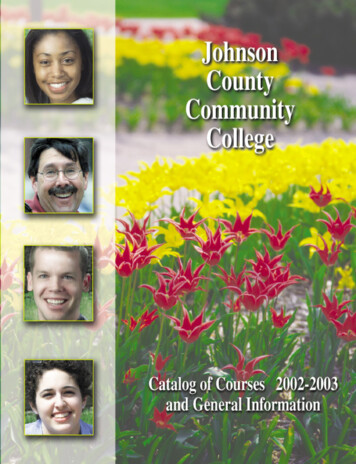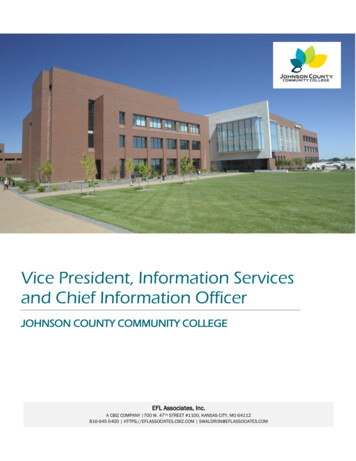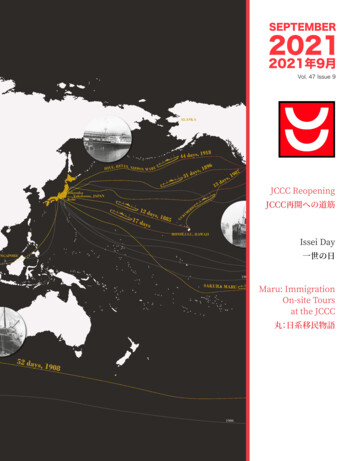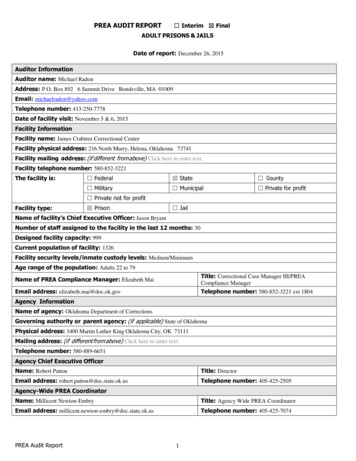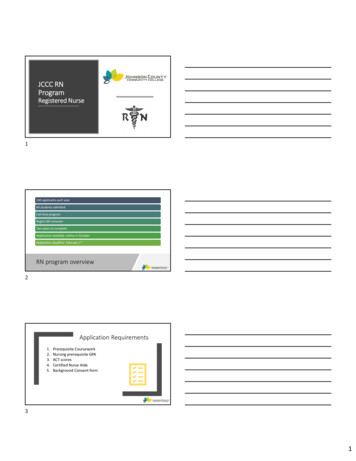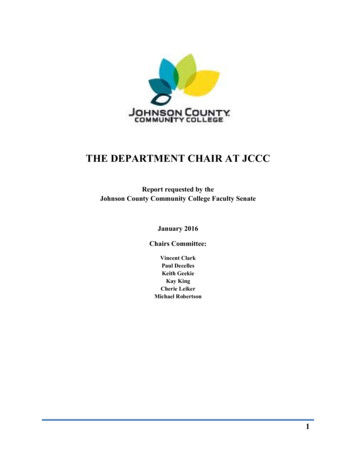
Transcription
THE DEPARTMENT CHAIR AT JCCCReport requested by theJohnson County Community College Faculty SenateJanuary 2016Chairs Committee:Vincent ClarkPaul DecellesKeith GeekieKay KingCherie LeikerMichael Robertson1
CONTENTSEXECUTIVE SUMMARY . 4BACKGROUND OF THE FACULTY SENATE DEPARTMENT CHAIRS REPORT . 5THE DEPARTMENT CHAIRS STUDY . 6THE DEPARTMENT CHAIR AT JCCC: THE HISTORY OF POSITION DESCRIPTIONS . 7THE FACULTY SENATE SURVEY: DEPARTMENT CHAIRS DESCRIBE THEIR WORK . 9The Survey Results .10Responses to Department Chairs Survey—Question 2: Key Tasks.11Discussion of Department Chairs Hourly Report of Key Tasks.12Responses to Department Chairs Survey—Questions 2 & 3: Additional Tasks .13THE DEPARTMENT CHAIRS SURVEY AND JCCC’S MISSION AND VALUES . 16DEPARTMENT CHAIRS AND JCCC’S MISSION. 17DEPARTMENT CHAIRS AND JCCC’S VALUES . 17DEPARTMENT CHAIRS AND COSTS . 23RECOMMENDATION OF THE FACULTY SENATE CHAIRS COMMITTEE. 24APPENDIX A . 25APPENDIX B . 32APPENDIX C . 36APPENDIX D . 39APPENDIX E . 43APPENDIX F . 47Survey Question 4 .47Survey Question 5 .542
Survey Question 6 .61Survey Question 7 .69Survey Question 8 .73Survey Question 9 .76Survey Question 10 .81Survey Question 11 .87APPENDIX G . 913
EXECUTIVE SUMMARYThis study examines the responsibilities, effectiveness, and cost of department chairs at JohnsonCounty Community College. It is based on a thorough examination of official collegedocuments, material supplied by the chief academic officer, and a detailed survey of departmentchairs themselves. It describes the history of the chairs model of organization, the results of anextensive survey of chair responsibilities and perceptions, the relationship of department chairsto the college mission and values statements, and the cost of department chairs compared withassistant deans.It shows that the college created departments headed by chairs in a 2008 academic reorganizationin order to strengthen academic standards, increase faculty cohesion, provide more effectivecollaboration, and align the college structure with that of other institutions of higher education.In its examination of chair responsibilities, it found that throughout the college, departmentchairs perform similar functions, but because of the diversity of courses and programs offered bythe college, some chair responsibilities vary by department. And the report reveals thatdepartment chairs have, in fact, proven adaptable to this wide variety of programs and courses. Italso found that the department chair, as an expert in an academic discipline, performs aninvaluable role in relations with the department, other parts of the college, outside institutions,and the community.The study also found that the chairs model is particularly suited to helping the college realize itsstated mission and values. This is partly because department chairs, as members of the facultyand administrators, are uniquely qualified to relate to students, fellow faculty members,administrators, and other members of the college community. The study also shows thatdepartment chairs perform a vast number of functions directly related to the college values ofintegrity, collaboration, responsiveness, leadership, and innovation. The chairs model, in fact,aligns with the transformational style of leadership upon which these values are based.The study also examined the cost of the department chairs and compared it with the cost ofreplacing department chairs with assistant deans. The additional cost of assistant deans amountedto more than one million dollars per year.On the basis of all this information, this study recommends retaining the chairs model.4
BACKGROUND OF THE FACULTY SENATEDEPARTMENT CHAIRS REPORTIn the Spring Semester 2015, it came to the attention of several members of the Faculty Senatethat the Instructional Deans Council, some members of the Board of Trustees, the Office of thePresident, and others on campus were curious about the department chairs position. Speculatingthat some up-coming administrative decisions might lead to yet another reorganization of thecollege’s governance structure, several members of the Faculty Senate urged that the Senateassemble information about the department chairs position in order to inform members of thecollege community about department chairs, their responsibilities, their cost, the scope of theirwork, and their effectiveness.On February 12, 2015, in response to a motion by Professor Jim Leiker, the Faculty Senaterequested that the position of department chair at JCCC be studied. A Senate Chairs Committeewas formed.5
THE DEPARTMENT CHAIRS STUDYThe Faculty Senate Chairs Committee obtained information for this study (1) by researching thecollege’s governance structure from Board Minutes, the campus website, and documents fromreorganization committees in 2008; (2) by conducting a survey of department chairs; and (3) byobtaining data from the Office of the Vice President of Academic Instruction.6
THE DEPARTMENT CHAIR AT JCCC:THE HISTORY OF POSITION DESCRIPTIONSThe position of department chair was created during the reorganization of JCCC’s instructionalbranch in 2008. At that time, under the direction of CAO Marilyn Rhinehart, two committeeswere formed, one to write the position description for academic deans and the other to write theposition description for department chairs for both transfer and career programs [See AppendixA & Appendix B].Before these committees were formed, no official departmental structure existed at JCCC.Instead, faculty members were affiliated by academic disciplines in various program iterations,names, and groupings, and under the leadership of various facilitators, program directors, andassistant deans, and also under ever-changing divisional titles and structures.However, under the new system, the first work for faculty members in each academic disciplineand career program was to create an actual department through writing a set of departmental bylaws, even if the department had only one full-time faculty member. Some of the academicdisciplines joined with other allied subject areas in order to create large departments, such asScience; some of the departments contained a single full-time faculty member, such as ArtHistory or Journalism; and still others contained a single academic discipline, such as Math orEnglish.Once the departments were created, the faculty members were to select department chairs. Fromthe beginning, the method for choosing the chair has been the responsibility of each department.Some department chairs are elected, some are chosen by consensus, some are made departmentchairs by necessity because the departments are small, and some are appointed. However,through whatever means they are chosen, department chairs are experts in and representatives ofspecific disciplines. For instance, the Department Chair of Fire Science is actually an expert infire science, and the Department Chair of Fine Art & Photography is actually a fine artist.1The extent of the responsibilities for each of the department chairs has always varied fromdepartment to department depending on many circumstances. It was generally assumed by thecommittee that wrote the department chairs position descriptions that the tasks and dutiesassigned to individual department chairs would vary, given that, say, the Chair of Biotech wouldhave duties similar to but not identical with the Chair of Humanities. However, it was alsoassumed the list of responsibilities for each chair should at least align with the original ChairPosition Description and with the by-laws for the department. The department chair’sresponsibilities should also be organized with the help of the division dean.1For a list of the department chairs and their credentials, see Appendix E.7
Overall, the department chair structure itself was meant to be adaptable to the wide variety ofcourses, programs, and careers that are offered at JCCC, which is by far the largest communitycollege in the area and one of the largest institutions of higher learning in Kansas.It should be noted that the designation “Department Chair” is applied almost universally acrosshigher education in the United States. It is a customary term used all the way from communitycolleges (and even in high schools) up to prestigious private universities in order to designate theleader of an academic discipline or program at an institution. When a department chair identifieshimself or herself as such, colleagues outside the JCCC community understand what that means.At the very least, the department chair is point person for that discipline in the college andinquiries from outside the institution can be easily directed to that person, as can inquiries fromstudents, advisors, counselors, faculty and members of other departments inside JCCC itself.It is the opinion of the Faculty Senate Chairs Committee that the creation of departments and theselection of department chairs gave to the academic disciplines and career programs in thecollege a much stronger sense of identity and gave faculty members in those disciplines andprograms much more investment in the institution. It is a structure that lends itself to inclusion,focus, flexibility, creativity, and innovation, as the following discussion will show.It should also be noted that faculty members, generally, do not become department chairs out ofa desire for power, though it can be a pathway to leadership. As Professor Don Chu notes in hisThe Department Chair Primer:Research tells us that very few chairs today agree to take on the job because theywant power. It’s not a career choice. It’s a choice based on the need to serve theirstudents, their colleagues, and the disciplines they represent. There is no onebetter positioned than the chair to do what is right and necessary. (3)2In Summary:A department chair is an approved designation in the structure of JCCC’s governance, asdescribed in Appendix A and Appendix B.A department chair is a nationally recognized title in colleges and universities.Further, a department chair Is an expert in an academic discipline or career program and has credentials andextensive teaching experience in that discipline2Don Chu. The Department Chair Primer: What Chairs Need to Know to Make a Difference. 2nd edition. JohnWiley & Sons, 2012.8
Works closely with students, faculty members, the division dean, and the publicAdvocates for the students, faculty and the discipline itself within and beyond the collegecommunityCoordinates and supervises the work of the department.THE FACULTY SENATE SURVEY:DEPARTMENT CHAIRS DESCRIBE THEIR WORKBackgroundOver the summer of 2015, the Faculty Senate Chairs Committee created a Department ChairQuestionnaire. Professor Michael Robertson created a Chairs Listserv for the distribution of thesurvey. During fall 2015 the questionnaire [Appendix C] was distributed to department chairs.Also, other information about department chairs was assembled.The Department Chairs Survey contained 11 questions. The second question on the surveyrequested numerical estimates of time spent on a variety of tasks. The survey included 9additional questions about the work associated with the position of department chair. The surveythus required department chairs to estimate hours spent on specific tasks per year, to listadditional tasks in their roles as department chairs, and to respond to broad questions about thenature and scope of the work as department chairs.The Survey ParticipantsTotal number of department chairs: Approximately 51Department chairs responding: 31 (60%)3Total number of sections for 2014-2015 for which the responding chairs wereresponsible: 4007Total number of full-time and adjunct faculty that the responding chairs represent: 675Those department chairs responding to the survey include the chairs of the largest departmentswith the most credit hours offered, along with many of the chairs of small departments, both intransfer and career programs.3For a list of department chairs along with a list of those who participated in the Department Chairs Survey, seeAppendix D. This list also includes each chair’s academic rank.9
The Survey ResultsThe Department Chairs Survey asked department chairs to indicate which of the 24 keyadministrative tasks they routinely perform.In the survey results, we find that almost all department chairs perform the same tasks, with theexception of the career program chairs, who work with advisory boards and with studentinternships.The Department Chairs Survey also asked that department chairs estimate the hours per year thatthey spent on these Key Tasks.A number of the department chairs maintained that it is difficult to calculate the number of hoursa task might take, such as hiring adjuncts or responding to student complaints, because thesetasks vary so much from day to day and semester to semester, and individual tasks themselvesmay be distributed over a number of days or even weeks.As Professor Jim Leiker, Chair of History & Political Science, remarked:It is difficult to estimate precise hours for each activity. Scheduling only happenstwo or three times a semester, but when it does, it demands that other work be puton hold and addressed immediately. If an adjunct suddenly quits, it may require40 to 60 hours to hire a new one. Student complaints tend to escalate near the endof the semester as they get worried about grades. I check emails at home in theevenings, worry about cancelling classes in my sleep, or have a bright idea andstart making notes about it while I’m on vacation. So I can’t say with trueaccuracy how many hours I do each of these because I rarely distinguish worktime from non-work time. More important than the total hours, which are roughestimates, are the weights given to these tasks.Though the job of a department chair is difficult to parse, a huge majority of the departmentchairs who returned the Department Chairs Survey attempted to do so.In the chart below, the results of the Department Chairs Survey list the Key Tasks performed bydepartment chairs and their hourly estimates.44Several of the department chairs returned their surveys by simply identifying the key tasks they performed but didnot submit estimates of the time they spent on these tasks. Also, one of the surveys had time estimates that were toohigh, so those numbers were removed from totals and averages as they would have skewed the results upward.10
Responses to Department Chairs Survey—Question 2: Key TasksThe Department Chairs Survey chart below shows that many tasks are performed by all of thedepartment chairs. For the 24 tasks listed, most department chairs (88%) perform the same tasksat a rate of 70% or higher.Number ofChairs whoIdentifiedthe Task asPart of TheirWorkPercentageof ChairsPerformingthe Task for31 ChairsAverageHours PerYear for 27ChairsTotal HoursReported for27 Chairsa. Planning (preparing for ongoing and newacademic and administrative initiatives)3098%521392b. Creating, advocating, and implementingchanges in curriculum31100%591591c. Representing your department in committeesand other groups31100%521391d. Representing your department to thecommunity3098%421164e. Achieving or maintaining accreditation or otherrecognition of your department2271%27724f. Scheduling classes and 31100%1912670k. Conferring with administrators31100%891246l. Coordinating and writing program reviews2994%67943m. Developing, coordinating, and reportingdepartment assessment2890%120730n. Developing and coordinating professionaldevelopment (including training and retraining,where applicable) of faculty members within yourdepartment2581%32444o. Organizing conferences, lectures, and otherevents2477%60846Key Taskg. Hiring, supervising, evaluating, and managingthe retention of department full-time facultymembersh. Hiring, supervising, evaluating, and managingthe retention of department adjunct facultymembersi. Meeting with faculty members in your area forother reasonsj. Dealing with student questions, complaints, andother matters11
Number ofChairs whoIdentifiedthe Task asPart of TheirWorkPercentageof ChairsPerformingthe Task for31 ChairsAverageHours PerYear for 27ChairsTotal HoursReported for27 Chairsp. Helping students acquire employment andinternships by mentoring, writingrecommendations, and providing additionalsupport2271%40700q. Developing, monitoring, and evaluatinginternships1445%34302r. Preparing budgets3098%20543s. Organizing and serving on advisory boards andcommittees2581%23626t. Marketing department programs2581%21561u. Tracking graduates2581%10138v. Ordering books, software, supplies, andequipment3098%891247w. Hiring, supervising and evaluating labassistants and other employees1342%19510x. Coordinating College Now instruction1342%16220Key TaskTotal Hours Reported on 27 Surveys for 24 Key Tasks: 23,916Discussion of Department Chairs Hourly Report of Key TasksThe accumulated total for all key tasks reported for 27 department chairs is 23,916 hours ofwork.Figuring a generous 50-hour work week, how many assistant deans would it take to performthese key tasks?23,916 hours of work 478 weeks @ 50 hours each.Assuming a 49- or 48-week works on an annual calendar, it would require 10 assistant deans toreplace the work of 27 department chairs on key tasks alone, much less all the other specializedtasks the department chairs perform in specific disciplines, keeping in mind that the departmentchairs also teach.It is obvious, that the resumption of the assistant dean’s model would reduce the amount of timethe institution spends with students, works on projects, and attends to related professionalmatters.12
Responses to Department Chairs Survey—Questions 2 & 3: Additional TasksIn addition to all the key tasks that the department chairs perform in common, individualdepartment chairs engage in numerous other activities related to their specific disciplines. Thesetasks are beneficial to students, the college, the community, and their professions. Below is a listof tasks listed by department chairs as belonging to their positions, all of which keep them busy:1.2.3.4.5.6.7.Developing and sharing innovative teaching methodsCommunicating with faculty via email, blogs, listservsTraining faculty on new softwareReviewing new softwareReviewing online teaching resourcesBeing the contact person for the college and studentsRepresenting and advocating for faculty to higher administrators regarding departmentalissues8. Leading self-evaluative projects handed down from administrators regardingdepartmental issues9. Fielding questions10. Training in Banner tasks11. Advising students12. Learning software so that other college area ask departments to do the work formallydone by others13. Preparing and/or updating program materials14. Brochures—designing, updating, and maintaining them15. Creating and overseeing pages on the JCCC website16. Meeting with book publisher representatives17. Preparing and planning major conferences18. Developing new programs and certificates19. Coordinating placement of students with the testing office20. Participating in alumni and student club activities and for some programs this is anextensive list21. Listing ITP requests22. Requesting remodeling of classrooms23. Working with the Welcome Center24. Meeting with prospective students25. Designing and implementing recruitment activities26. Conducting exit interviews with students in capstone classes27. Keeping up with the constantly changing systems across campus: online leave reportingand leave approval; moving from CORS to CIM/PIM (which regular faculty can avoid bynot being engaged with curriculum changes.but chairs can't avoid it); moving our owncontent from ANGEL to D2L and supporting the transition for all of our faculty, both FT13
and adjunct; adjusting ourselves AND supporting our faculty in adjusting to electroniccourse evaluations, in addition to the above-noted new duty of pulling evaluation resultsfrom the system for all of our faculty; transitioning to a new system for DocumentServices requests.28. Developing articulation agreements (colleges, high schools)29. Writing grants30. Checking enrollment continuously and adding classes and staff when needed31. Locating substitutes32. Discerning KBOR tasks (realignment, curriculum, and certifications)33. Working on KBOR and Compass replacement with Accuplacer survey and committeework34. Complying with credentials requests (submit federal student OSHA)35. Recruiting (student visits, tours)36. Locating scholarships and helping students apply37. Issuing waivers and overrides38. Vetting software and hardware upgrades39. Performing Perkins tasks (inventory equipment and requests)40. Attending KCOG meetings41. Attending meetings of professional groups in the field42. In BIOT participating with Kansas Bioscience Organization, KC Stem Alliance, KansasCity Area Life Sciences Institute43. Working with Science Resource Center – help to hire tutors, assist with science week,assist with campus kick-off etc.44. Outreaching to high schools, host high schools, judge high school science fairs, workwith BV CAPS, Olathe, SMSD, & Lawrence45. Working with career & tech education, Grant/STEM activities (some applicable to BIOT)– STEM conferences, meet with career & tech ed teachers, and other career & tech edinitiatives46. Working with Career Center – disseminate job postings, job shadowing47. Developing transfer programs to UMKC, KU-Edwards, etc. – implement and maintaintransfer agreements48. Outreaching to industry – visiting with area biotechnology industries and scientificstaffing agencies for internship opportunities for students49. Updating, maintenance and collaboration with partners to produce Biotechnologymaterials (some materials were originally grant funded, others are regular promotionalmaterials) to promote JCCC and biotechnology within the academic and industrialcommunity50. Taking inventories of equipment51. Maintaining AWS Library14
52. Assessing (and coordinating assessment of) students’ preparation for placement in ourcourses53. Developing 39 new AWS D15.1 welding code specifications and qualifications for fiveclasses54. Maintaining the welding lab55. Maintaining equipment56. Sending emails, scheduling appointments, trying to find documents on infoshare,speaking with staff to locate someone to help me with a problem, trying to figure outwhat paperwork to use, waiting for helpdesk to return calls, attending mandatory training,getting faculty to attend mandatory training, filling out surveys like this one.57. Evaluating transfer credit58. Organizing in-service sessions for professional development.59. Performing numerous tasks associated with studios, their equipment, faculty and staffoffices, software, dark rooms, etc.60. Directing and curating the Student Art Gallery in the Student Center which includes:creating student shows, hanging the shows, creating the posters, and doing the publicityfor those exhibitions61. Photographing all the work for the inventory records62. Attending advisory board meetings, networking with industry, networking with K-State,networking with Gov. Agencies to provide career opportunities, scholarship opportunities63. Responding to phone calls in chair capacity from community (name on every ScienceDepartment web page)64. Working with Maintenance and/or Risk Manager on issues that arise with eye washstations, safety showers, equipment, instruments, accommodation issues, hoods, etc.65. Maintaining the “science office” email account (answering the hundreds of emails thatcome in every semester).66. Monitoring department Honors mentors67. Training/retraining (Banner, XiTracks, Red Carpet Hiring, Class Climate— our newonline student evaluation report)68. Monitoring Portfolio Review (Faculty)15
THE DEPARTMENT CHAIRS SURVEYAND JCCC’S MISSION AND VALUESAccording to Shahnaz Aziz, Morell E. Mullins, et al., “The academic department chair occupiesa central position within higher education, functioning simultaneously as faculty (i.e. the staff ofa department within a university or college devoted to a particular branch of knowledge) andadministrator, with responsibility for a wide variety of tasks and activities directed towardmultiple constituencies. In describing the importance and nature of the role of the departmentchair, Leaming (1998) noted that ‘The department chair is the glue [of the institution], serving asthe link between faculty and administration, between the discipline and the institution, andoccasionally between faculty and parents’ (p. ix)” (571).5The Faculty Senate Chairs Committee believes that the department chairs position is central tothe Mission, Vision and Values of JCCC, which are stated as follows:MISSIONJCCC inspires learning to transform lives and strengthen communities.VISIONJCCC will be a national leader through educational excellence and innovation.VALUESIntegrity - We hold ourselves accountable for decisions and actions.Collaboration - We respect diversity of thought in building a culture of collaboration.Responsiveness - We respond to the needs of our students and communities throughrelevant offerings.Leadership - We pursue leadership roles in our communities and higher education.65Shahnaz Aziz, Morell E. Mullins, et al. “Understanding the Training Needs of Department Chairs.” Studies inHigher Education 30: 5 (2005): 571-593. PDF.6“Mission, Vision & Values.” Johnson County Community College. Johnson County Community College, 2015.Web.11 Nov. 2015.16
DEPARTMENT CHAIRS AND JCCC’S MISSIONDepartment chairs are central to the Mission of JCCC because they foster a strong sense ofcommunity. The role of department chair is above all one that engages with people. As thesurvey indicates, department chairs are a nexus for human relationships between faculty members and studentsbetween department faculty members themselvesbetween students and student service members in registration and counselingbetween students and the staff who assist in such areas as scholarships, internationalopportunities, and the Honors Programbetween faculty members in different departmentsbetween faculty members and major college-wide committeesbetween the department faculty and those who provide textbooks, software training andupdates, materials for labs, and those who work in labs and resource centersbetween department faculty who have good ideas or concerns and college administratorsbetween department faculty and faculty at transfer institutionsbetween department faculty and those community members in relevant professionalorganizations and careers, and on advisory boards.Because department chairs are experts and teachers in the fields for the departments in whichthey work, they can speak with authority on behalf of their faculty and on behalf of the studentswho take their courses. They can encourage both students and faculty. They can seek and seizeopportunities for the betterment of
THE DEPARTMENT CHAIR AT JCCC: THE HISTORY OF POSITION DESCRIPTIONS The position of department chair was created during the reorganization of JCCC's instructional branch in 2008. At that time, under the direction of CAO Marilyn Rhinehart, two committees



